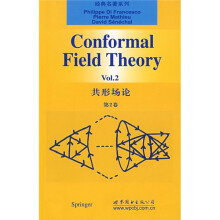8.A.3 The Singular Vectors |hr,s+rs”>:General Strategy
8.A.4,the Leading ActionofA△ r,1
8.A.5 Fusion at Work
8.A.6 The Singular Vectors |hr,s+rs>:Summary Exercises
9 The Coulomb-Gas Formalism
9.1 Vertex Operators
9.1.1 Corrclators of Vertex Operators
9.1.2 the Neutrality Condition
9.1.3 the Back ground Charge
9.1.4 the AnomalOUS OPES
9.2 Screening Operators
9.2.1 Physical and Vertex Operators
9.2.2 Minimal Models
9.2.3 Four-POint Functions:Sample Correlators
9.3 Minimal Models:General Structure of Correlation Functions
9.3.1 Conformal Blocks for the Four-Point Functions
9.3.2 Conformal Blocks for the N-Point Function on the Plane
9.3.3 Monodromy and Exchange Relations for Conformal Blocks
9.3.4 Conformal Blocks for Corrclators on a Surface of Arbitrary Genus
9.A Calculation of the Energy-Momentum Tensor
9.B Screened Vertex Operators and BRST Cohomology:A Proof of the Coulomb-Gas Representation Of Minimal Models
9.B.1 Charged Bosonic Fock Spaces and Their Virasoro Structure
9.B.2 Screened Vertex Operators
9.B.3 The BRST Charge
9.B.4 BRST Invariance and Cohomology
9.B.5 The Coulomb-Gas Representation Exercises
10 Modular Invariance
10.1 C0nformal Field Theory on the Torus
10.1.1 The Partition Function
10.1.2 Modular Invariance
10.1.3 Generators and the Fundamental Domain
10.2 The Free Boson on the Torus
10.3 Free Fermions on the Torus
10.4 Models with C=1
10.4.1 Compactified Boson
10.4.2 Multi-Component Chiral Boson
10.4.3 Orbifold
10.5 Minimal Models:Modular Invariance and operater Content
10.6 Minimal Models:Modular Transformations of the Characters
10.7 MinimaI Models:Modular lnvariant Partition Funcfions
10.7.1 Diagonal Modular Invariants
10.7.2 Nondiagonal Modular Invariants:Example of the Three-state Potts Model
10.7.3 Block-Diagonal Modular Invariants
10.7.4 Nondiagonal Modular Invariants Related to an Automorphism
10.7.5 D Seriesfrom Z2 OrbifoldS
10.7.6 The Classification of Minimal Models
10.8 Fusion Rules and Modular Invariance
10.8.1 verlindeS Formula for Minimal Theories
10.8.2 Counting Conformal Blocks
10.8.3 A General Proof of Verlindes Formula
10.8.4 Extended Symmetries and Fusion Rules
10.8.5 Fusion Rules of the Extended Theory of the Three-State Potts Model
10.8.6 A Simple Example of Nonminimal Extended Theory:The Free Boson at the Self-Dual Radius
10.8.7 Rational Conformal Field Theory:A Definition
10.A Theta Functions
10.A.1 The Jacobi Tripie Product
10.A.2 Theta Functions
10.A.3 DedekindS n Funcfion
10.A.4 Modular Transformations of Theta Functions
10.A.5 Doubling Identities Exercises
11 Finite-Size Scaling and Boundaries
11.1 Conformal Invariance on a Cylinder
11.2 Surface Critical Behavior
11.2.1 Conforrnal Field rnleory on the Upper Half-Plane
11.2.2 The Ising Model on the Upper Half-Plane
11.2.3 The Infinite Strip
11.3 Boundary Operators
11.3.1 Introduction
11.3.2 Boundary States and the Verlinde Formula
11.4 Critical Percolation
11.4.1 Statement of the Problem
11.4.2 Bond Percolation and the Q-state POtts Model
11.4.3 Boundary Operators and Crossing Probabilities Exercises
12 The Two-Dimensional Ising Modd
12.1 The Statistical Model
12.2 The Underlying Fermionic Theory
12.2.1 Fermion:Energy and Energy-Momentum Tensor
12.2.2 Spin
12.3 Correlation Functions on the Plane by Bosonization
12.3.1 the Bosonization Rules
12.3.2 Energy Correlators
12.3.3 Spin and General Correlators
12.4 The Ising Model on the Torus
12.4.1 The Partition Function
12.4.2 General Ward Identifies on the Torus
12.5 Correlation Functions on the Torus
12.5.1 Flermion and Energy Correlators
12.5.2 Spin and Disorder-Field Correlators
12.6 Bosonization on the Torus
12.6.1 The Tw0 Bosonizations of the Ising Model:Partition Functions and Operators
12.6.2 Compactified Boson Correlations on the Plane and or the Torus
12.6.3 Ising Correlators from the Bosonization of the Dirac Fermion
12.6.4 Ising Correlators from the Bosonization of Two Real Fermions
12.A Elliptic and Treta Function Identities
12.A.1 Generalities on Elliptic Functions
12.A.2 Periodicity and ZeroS of the Jacobi Theta Functions
12.A.3 Doubling Identifies Exercises
Part C CONOFRMAL FIELD THEORIES WITH LIE-GROUP SYMMETRY
13 Simple Lie Algebras
13.1 The Structure of Simple Lie Algebras
13.1.1 TheCartan-Wevl Basis
13.1.2 The Killing Form
13.1.3 Weigllts
13.1.4 Simple Roots and the Caftan Matrix
13.1.5 The Chevalley Basis
13.1.6 Dynkin Diagrams
13.1.7 Fundamental Weights
13.1.8 TheWeyl Group
13.1.9 Lattices
13.1.10 Normalization Convention
13.1.11 Examples
13.2 Highest-Weight Representations
13.2.1 Weights and Their Multiplicities
l3.2.2 Conjugate Representations
13.2.3 Quadratic Casimir Operator
13.2.4 Index of a Representation
13.3 Tableaux and Patterns (su(N))
13.3.1 Young Tableaux
13.3.2 Partitions and Orthonormal Bases
13.3.3 Semistandard Tableaux
13.3.4 Gelfand-Tsetlin Paaerns
13.4 Characters
13.4.1 WleylS Character Formula
13.4.2 The Dimension and the Strange Formulae
13.4.3 Schur Functions
13.5 Tensor Products:Computational Tools
13.5.1 The Character Method
13.5.2 Algorithm for the Calculation of Tensor Products
13.5.3 The Littlewood-Rchardson Rule
13.5.4 Berenstein-Zelevinsky Triangles
13.6 Tensor Products:A Fusion-Rule Point of View
13.7 Algebra Embeddings and Branching Rules
13.7.1 Embedding Index
13.7.2 Classification of Embeddings
13.A Properties of Simple Lie Algebras
13.B Notation for Simple Lie Algebras Exercises
14 Affine Lie Algebras
14.1 The Structure Of AfIine Lie Algebras
14.1.1 From Simple Lie Algebras to Affine Lie Algebras
14.1.2 The killing Form
14.1.3 Simple Roots,the Cartan Matrix and Dynkin Diagrams
14.1.4 The ChevalIcy Basis
14.1.5 Fundamental Weights
14.1.6 The Affine Weyl Group
14.1.7 Examples
14.2 Outer Automorphisms
14.2.1 Symmetry of the Extended Diagram and Group of Outer Auto morphisms
14.2.2 Action of Outer Automorphisms on Wleights
……
15 WZW Models
16 Fusion Rules in WZW Models
17 Modular Invariants in WZW Models
18 Cosets
References
Index

 缺书网
缺书网 扫码进群
扫码进群





